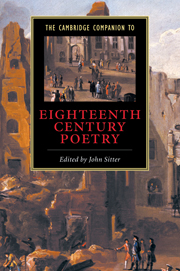Book contents
- Frontmatter
- 1 Introduction
- 2 Couplets and conversation
- 3 Political passions
- 4 Publishing and reading poetry
- 5 The city in eighteenth-century poetry
- 6 “Nature” poetry
- 7 Questions in poetics
- 8 Eighteenth-century women poets and readers
- 9 Creating a national poetry
- 10 The return to the ode
- 11 A poetry of absence
- 12 The poetry of sensibility
- 13 “Pre-Romanticism” and the ends of eighteenth-century poetry
- Index
11 - A poetry of absence
Published online by Cambridge University Press: 28 May 2006
- Frontmatter
- 1 Introduction
- 2 Couplets and conversation
- 3 Political passions
- 4 Publishing and reading poetry
- 5 The city in eighteenth-century poetry
- 6 “Nature” poetry
- 7 Questions in poetics
- 8 Eighteenth-century women poets and readers
- 9 Creating a national poetry
- 10 The return to the ode
- 11 A poetry of absence
- 12 The poetry of sensibility
- 13 “Pre-Romanticism” and the ends of eighteenth-century poetry
- Index
Summary
A poetics of absence appropriate to the eighteenth century would take as its distinctive image not the void or abyss - where the rich material world encounters its opposite state of nothingness - but the ruin. Ruins are the trace of something that has vanished. As eighteenth-century poets employ the image, a ruin is less the sign of a distinct past, like the famous monument commemorating the London fire, than an evocation of something lost beyond recovery while nonetheless still persisting in fragments, remnants, and flashes of recollection. The ruin gives absence, so to speak, a material dwelling: a rock-solid site that, paradoxically, embodies a sense that the world is also porous, uncertain, and insubstantial. Its power in eighteenthcentury poetry derives from this implicit doubleness combining solidity with evanescence, like Rome as Piranesi depicted it in his Vedute di Roma (begun in the late 1740s), with shrubs sprouting from tumbledown classical arches, fallen statues beside overgrown temples, wooden shacks propped against the cenotaphs. John Dyer created his own version of this imagery in The Ruins of Rome (1740):
the solemn scene Elates the soul, while now the rising sun Flames on the ruins in the purer air Tow’ring aloft, upon the glitt’ring plain, Like broken rocks, a vast circumference; Rent palaces, crush’d columns, rifled moles, Fanes roll’d on fanes, and tombs on buried tombs.
- Type
- Chapter
- Information
- The Cambridge Companion to Eighteenth-Century Poetry , pp. 225 - 248Publisher: Cambridge University PressPrint publication year: 2001
- 2
- Cited by



